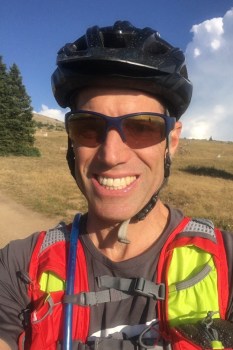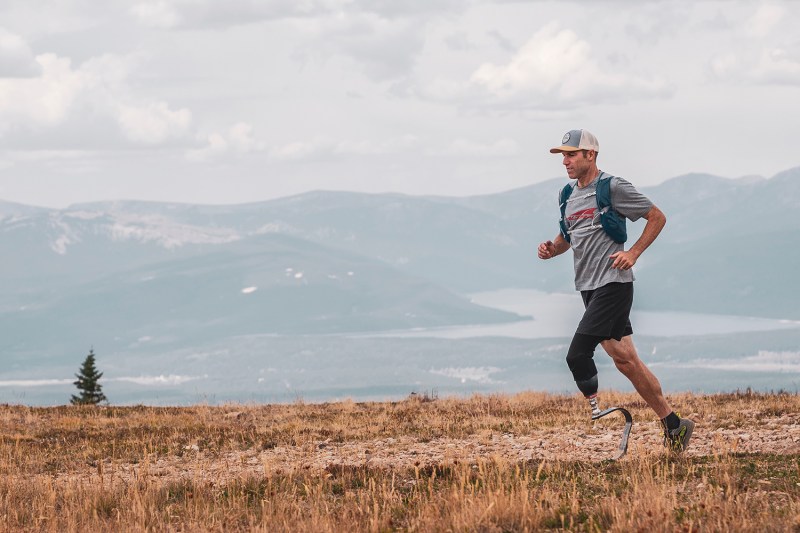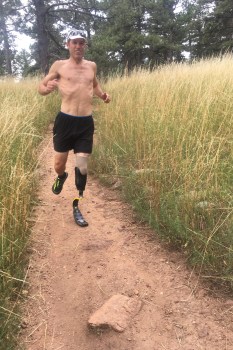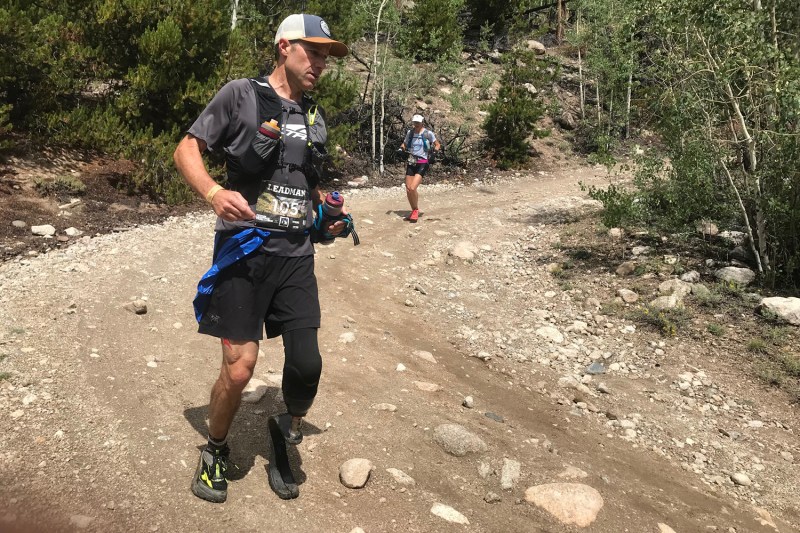The morning of May 23, 2015, is permanently etched into the mind of ultrarunner Dave Mackey. He left from his home in Boulder, Colorado, for a routine three-hour trail run to the summit of South Boulder Peak, following a ridgeline leading to Bear Peak and onward before returning home. It wasn’t a new trail; it was one that he had run many times before. After reaching the summit of Bear Peak, Mackey began his descent. The rock that would prove to be his nemesis that day was one that he had stepped on numerous times over the years without faltering once. However, on that day, the roughly 300-pound boulder dislodged when he stepped on it, sending him tumbling down the rocky slope. After falling approximately 50 feet, Mackey came to an abrupt stop, landing on this back. The rock quickly followed and came to rest on his lower left leg, pinning him to the ground and crushing his leg beneath its weight.
In excruciating pain, Mackey called out. A friend and fellow runner who was in the vicinity heard him and quickly responded. He was able to leverage the boulder from Mackey’s leg, exposing the open tibia fracture. After a four-hour rescue operation, Mackey was down the mountain and on his way to the hospital.

Over the next 16 months, Mackey endured 14 surgeries in an attempt to repair his leg. The initial open fracture exposed his bone and tissue to a parade of infections that would impede healing even a year after the accident.
“Even though the initial surgery was for a complicated fracture, I had no reason to believe I wouldn’t recover fully,” Mackey says. “My surgeon believed that as well.”
“That persistent infection from the open fracture was the kicker,” he adds.
His bones never healed fully and he was subjected to numerous surgeries in the following months which involved soft tissue and muscle repair, bone grafting, and additional hardware to aid in walking.
In September 2016, after being sidelined for over a year, beset with countless surgeries, unbearable pain, and unfavorable results, Mackey made the decision to have his left leg amputated below the knee.
Just 20 months after the surgery, Mackey completed the entire Leadville Race Series, an ultramarathon held in Colorado. Just completing one of the events in the series is a huge accomplishment for most athletes. For perspective, the entire series is comprised of a 10K run, a trail marathon, 50- and 100-mile runs, and 50- and 100-mile bike rides.

Dave Mackey is no stranger to standing on the podium in the ultrarunning world. He holds the fastest known time on the Grand Canyon Rim-to-Rim-to-Rim at under seven hours. In 2011, he was voted Ultrarunning Magazine’s North American Ultrarunner of the Year.
We caught up with Dave Mackey to discuss his life before, after, and now the future for this ultrarunning icon.
The Manual: What was the greatest hurdle you faced after making the decision to move forward with the amputation?

Dave Mackey: The greatest hurdle I faced was coming to the terms that this was not a decision that I could revisit. It was a one-way path. Becoming an amputee was not something I had ever seen myself becoming. Once this choice was made, though, I felt liberated in many ways as my path was clear and definite, and I knew many amputees were out there doing incredible things even better than non-amputees.
TM: Would your decision have been different if the injury was above the knee?
DM: If my injury was above the knee, I would have made the same choice, I think. But there are subtleties to [above-knee amputation] that are different and maybe I would have opted to try more surgeries. Hard to say though.
TM: What was the moment when it became clear that amputation was the path?
Once this choice was made, though, I felt liberated in many ways as my path was clear and definite, and I knew many amputees were out there doing incredible things even better than non-amputees.
DM: When I found that there were many other surgeries with limited chance of success, after talking with my surgeons, close friends, and my wife. It wasn’t a moment really versus a period of weeks.
TM: How did your family react to your decision?
DM: My wife was supportive overall and we were in agreement that this was the best choice. She and I were on the same page. She understood my goals of having a nonfunctioning leg the rest of my life, which would be an anchor, versus something useful to propel me.
TM: What was the recovery time between amputation and prosthetic?
DM: It took a solid year to be “recovered” from surgery, in the aspect I could go for runs, if that is what recovery is. But to adapt to the prosthetic takes time because the residual limb is still reducing over a period of a year, and it is easy to have rubbing or chafing from a prosthetic socket that changes fit from week to week. Once my leg is in a stable place in size after that year, it was full steam ahead.

TM: Other than the obvious, is there anything you’ve had to change about your training?
DM: My training is different now in that I go for runs about four days per week instead of six days per week and run about 11-12 miles each run; I actually put more miles on my mountain bike and on skis than running. The skin can be easy to break down on my limb so too many running miles actually means I can be set back more than before, so balancing out with other activities is important. I love biking and skiing, which I actually do just as well as I did before my accident.
TM: Have people treated you any differently since your accident and subsequent surgery?
- Range of Motion Project
- Suffer Better
- Challenged Athletes Foundation
- American Trail Running Association
DM: People whom I don’t know who see me on the trails on my running blade do sometimes make supportive comments like, “good job” or “way to go,” which is cool. Otherwise, my friends and family treat me the same. My kids make fun of me here and there but they’ve always been jokers even before my accident.
TM: Have other amputees reached out to you and have they been inspired by your story?
DM: A couple of amputees have reached out to me after the accident and amputation, and I hope I’ve helped them in some way. I hope I’ve helped reinforce patience most of all in this process.
TM: Are there any new causes you are involved with as an adaptive athlete?
DM: Range of Motion Project, Suffer Better, Challenged Athletes Foundation. I’ve been in with ATRA (American Trail Running Association) for about 17 years as a board member.
I have a deeper sense of accomplishment … However, I was still extremely happy running races even back then.
TM: How does it feel now, physically and emotionally, crossing the finish line?
DM: I have a deeper sense of accomplishment. That is for sure. And the process of running and completing races is more satisfying than before when I was actually racing. However, I was still extremely happy running races even back then. Running and doing other sports has always given me health and joy throughout life.
TM: What are your goals for 2019? Any dream races you have your eyes on for the future?
DM: I have the Western States 100 in June, Leadman series again in June through August, and then Eco-Challenge adventure race in September. A full four months of adventure. I might have to quit my day job as a physician assistant.
Editors' Recommendations
- How Love Got Michael Phelps Back Into Olympic Shape
- Altra Running Shoes’ Brian Beckstead Shares the Story of His Well-Trod Road to Success


